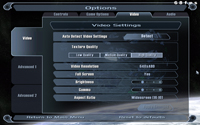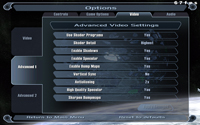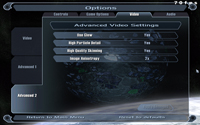BFGTech 8600 GTS OC2 ThermoIntelligence
Written by Tim Smalley
September 14, 2007 | 16:00
Tags: #8600 #bfg #bfgtech #comparison #evaluation #fps #frame #geforce #gts #heatsink #intelligence #overclocking #performance #rate #review #temperatures #thermointelligence

Prey
Publisher: 2K GamesWe used the full retail version of Prey, patched to version 1.3. The game, developed by Humanhead Studios, is based on an enhanced version of the Doom 3 engine. It features many unique gameplay features including gravity flipping and gravity walking -- these allow you to walk on walls or ceilings, making for some very interesting gameplay. Because of these features, it's very easy to get disorientated whilst playing Prey on a big screen.
On the graphics front, the engine is based on OpenGL and supports bump mapping, dynamic shadowing, glow effects, particle effects, specular lighting, skinning and high-quality textures. Although the Doom 3 engine is almost three years old, it still looks pretty stunning -- that's a testament to how well the Doom 3 engine has aged.
For our testing, we used a demo from the Salvage level, which incorporates all of the effects we've discussed above. Based on our experiences, we found that the Salvage level was the most intense level in the game, so it should serve well as a 'worst case' scenario in this title.
We set the in-game quality settings to their highest selectable options, leaving vsync disabled. Anti-aliasing and anisotropic filtering were controlled inside the game via the command line, but there is the option to select them in the game's display options menus.
Prey
1024x768, 4xAA 8xAF, Maximum Quality
- Nvidia GeForce 8800 GTS 320MB
- ATI Radeon X1950 XT 256MB
- ATI Radeon X1950 Pro 256MB
- Nvidia GeForce 7900 GS 256MB
- BFGTech GeForce 8600 GTS OC2 256MB SLI
- BFGTech GeForce 8600 GTS OC2 256MB
- Nvidia GeForce 8600 GTS 256MB
- XFX GeForce 8600 GT 620M XXX 256MB
- ATI Radeon X1650 XT 256MB
- HIS Radeon HD 2600 XT IceQ Turbo 256MB GDDR3
- Asus EN8600GT 256MB
- Sapphire Radeon HD 2600 XT 256MB GDDR4
- Nvidia GeForce 7600 GT 256MB
-
-
103.6
-
-
-
88.4
-
-
-
78.8
-
-
-
77.7
-
-
-
73.5
-
-
-
69.7
-
-
-
66.5
-
-
-
62.9
-
-
-
58.3
-
-
-
53.8
-
-
-
52.1
-
-
-
52.0
-
-
-
50.5
-
0
25
50
75
100
Frames Per Second
-
Average
Prey
1280x1024, 0xAA 8xAF, Maximum Quality
- Nvidia GeForce 8800 GTS 320MB
- ATI Radeon X1950 XT 256MB
- BFGTech GeForce 8600 GTS OC2 256MB SLI
- ATI Radeon X1950 Pro 256MB
- Nvidia GeForce 7900 GS 256MB
- HIS Radeon HD 2600 XT IceQ Turbo 256MB GDDR3
- BFGTech GeForce 8600 GTS OC2 256MB
- Sapphire Radeon HD 2600 XT 256MB GDDR4
- Nvidia GeForce 8600 GTS 256MB
- XFX GeForce 8600 GT 620M XXX 256MB
- ATI Radeon X1650 XT 256MB
- Nvidia GeForce 7600 GT 256MB
- Asus EN8600GT 256MB
-
-
101.1
-
-
-
82.4
-
-
-
81.1
-
-
-
79.1
-
-
-
75.8
-
-
-
71.5
-
-
-
67.3
-
-
-
65.5
-
-
-
61.1
-
-
-
59.2
-
-
-
55.4
-
-
-
51.2
-
-
-
49.9
-
0
25
50
75
100
Frames Per Second
-
Average
Prey
1280x1024, 4xAA 8xAF, Maximum Quality
- Nvidia GeForce 8800 GTS 320MB
- ATI Radeon X1950 XT 256MB
- BFGTech GeForce 8600 GTS OC2 256MB SLI
- ATI Radeon X1950 Pro 256MB
- Nvidia GeForce 7900 GS 256MB
- BFGTech GeForce 8600 GTS OC2 256MB
- Nvidia GeForce 8600 GTS 256MB
- XFX GeForce 8600 GT 620M XXX 256MB
- ATI Radeon X1650 XT 256MB
- HIS Radeon HD 2600 XT IceQ Turbo 256MB GDDR3
- Sapphire Radeon HD 2600 XT 256MB GDDR4
- Asus EN8600GT 256MB
- Nvidia GeForce 7600 GT 256MB
-
-
88.0
-
-
-
69.2
-
-
-
62.3
-
-
-
61.6
-
-
-
55.0
-
-
-
48.2
-
-
-
45.8
-
-
-
42.9
-
-
-
41.2
-
-
-
38.6
-
-
-
36.2
-
-
-
36.1
-
-
-
36.0
-
0
10
20
30
40
50
60
70
80
90
Frames Per Second
-
Average
Prey
1680x1050, 0xAA 8xAF, Maximum Quality
- Nvidia GeForce 8800 GTS 320MB
- ATI Radeon X1950 XT 256MB
- ATI Radeon X1950 Pro 256MB
- BFGTech GeForce 8600 GTS OC2 256MB SLI
- Nvidia GeForce 7900 GS 256MB
- HIS Radeon HD 2600 XT IceQ Turbo 256MB GDDR3
- Sapphire Radeon HD 2600 XT 256MB GDDR4
- BFGTech GeForce 8600 GTS OC2 256MB
- Nvidia GeForce 8600 GTS 256MB
- ATI Radeon X1650 XT 256MB
- XFX GeForce 8600 GT 620M XXX 256MB
- Nvidia GeForce 7600 GT 256MB
- Asus EN8600GT 256MB
-
-
92.3
-
-
-
72.9
-
-
-
68.7
-
-
-
67.2
-
-
-
60.7
-
-
-
59.5
-
-
-
54.4
-
-
-
53.4
-
-
-
49.2
-
-
-
47.9
-
-
-
46.8
-
-
-
41.3
-
-
-
35.1
-
0
25
50
75
100
Frames Per Second
-
Average
Prey
1680x1050, 2xAA 8xAF, Maximum Quality
- Nvidia GeForce 8800 GTS 320MB
- ATI Radeon X1950 XT 256MB
- ATI Radeon X1950 Pro 256MB
- BFGTech GeForce 8600 GTS OC2 256MB SLI
- Nvidia GeForce 7900 GS 256MB
- BFGTech GeForce 8600 GTS OC2 256MB
- ATI Radeon X1650 XT 256MB
- Nvidia GeForce 8600 GTS 256MB
- XFX GeForce 8600 GT 620M XXX 256MB
- HIS Radeon HD 2600 XT IceQ Turbo 256MB GDDR3
- Nvidia GeForce 7600 GT 256MB
- Sapphire Radeon HD 2600 XT 256MB GDDR4
- Asus EN8600GT 256MB
-
-
78.9
-
-
-
68.0
-
-
-
58.7
-
-
-
54.7
-
-
-
52.0
-
-
-
40.2
-
-
-
39.8
-
-
-
38.1
-
-
-
36.1
-
-
-
35.3
-
-
-
35.1
-
-
-
33.1
-
-
-
30.1
-
0
10
20
30
40
50
60
70
80
Frames Per Second
-
Average
Again, SLI scaling kicks in at 1280x1024 and the performance increases are fairly respectable. Single card performance is a little underwhelming because the card isn't anywhere near to putting up a fight against last generation's mid-range hardware. The knife in the side is the GeForce 8800 GTS 320MB's performance advantage that only increases when the resolution scales.












Want to comment? Please log in.